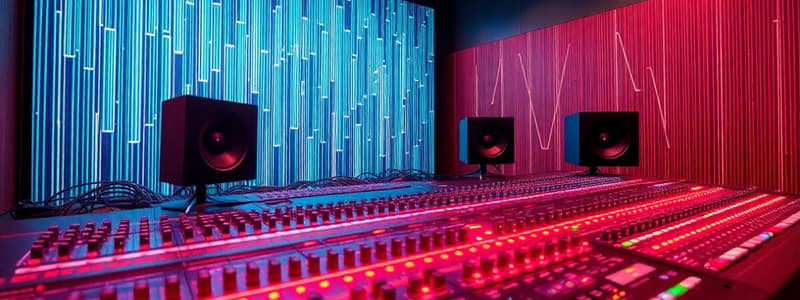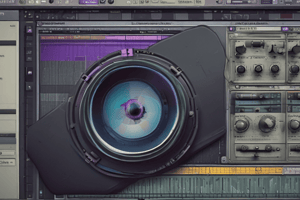Podcast
Questions and Answers
What is one of the primary purposes of EQ plugins in a Digital Audio Workstation?
What is one of the primary purposes of EQ plugins in a Digital Audio Workstation?
- To compress audio signals for louder playback.
- To enhance the visual elements of audio tracks.
- To provide flexible equalization adjustments. (correct)
- To automate the mixing process without manual intervention.
How can equalization affect the 'presence' of a sound?
How can equalization affect the 'presence' of a sound?
- By applying reverb to the audio signal.
- By adjusting the prominence of certain frequencies. (correct)
- By lowering the overall volume of the track.
- By increasing distortion on the sound.
What is a potential use of EQ in the mixing process?
What is a potential use of EQ in the mixing process?
- To remove reverb effects from tracks.
- To entirely replace audio signals.
- To create a louder mix by clipping audio peaks.
- To correct tonal imbalances across multiple channels. (correct)
What does emphasizing specific frequencies with EQ achieve?
What does emphasizing specific frequencies with EQ achieve?
Specific EQ curves are intended to address what aspect of sound design?
Specific EQ curves are intended to address what aspect of sound design?
What is the primary function of dynamic processing in audio technology?
What is the primary function of dynamic processing in audio technology?
Which dynamic processing technique is used to prevent audio clipping?
Which dynamic processing technique is used to prevent audio clipping?
What is the main goal of using compressors in dynamic processing?
What is the main goal of using compressors in dynamic processing?
Which type of EQ provides the most precise control over specific frequency bands?
Which type of EQ provides the most precise control over specific frequency bands?
How does an expander differ from a compressor?
How does an expander differ from a compressor?
What is a primary benefit of using EQ processors in audio processing?
What is a primary benefit of using EQ processors in audio processing?
Which type of EQ breaks audio into multiple bands for in-depth control?
Which type of EQ breaks audio into multiple bands for in-depth control?
What role does dynamic processing play in achieving consistent volume levels throughout a mix?
What role does dynamic processing play in achieving consistent volume levels throughout a mix?
Flashcards
EQ Plugins
EQ Plugins
Digital plugins that allow you to adjust the frequency balance of audio signals within a Digital Audio Workstation (DAW).
Presence (Audio)
Presence (Audio)
The relative prominence of certain frequencies in an audio signal, influencing the perceived warmth or brightness of a sound.
Immediacy (Audio)
Immediacy (Audio)
Adjustments in equalization that impact the overall feeling of space, warmth, or how forward a sound appears.
Correcting Tonal Imbalances
Correcting Tonal Imbalances
Signup and view all the flashcards
Emphasizing Frequencies
Emphasizing Frequencies
Signup and view all the flashcards
Sound Forming
Sound Forming
Signup and view all the flashcards
Dynamic Processing
Dynamic Processing
Signup and view all the flashcards
Audio Compression
Audio Compression
Signup and view all the flashcards
Audio Expansion
Audio Expansion
Signup and view all the flashcards
Limiting
Limiting
Signup and view all the flashcards
Gate/Expander
Gate/Expander
Signup and view all the flashcards
EQ Processor
EQ Processor
Signup and view all the flashcards
Graphic EQ
Graphic EQ
Signup and view all the flashcards
Study Notes
Sound Forming in Audio Technology
- Sound forming in audio technology encompasses various techniques and processes used to shape the sonic characteristics of audio signals.
- This includes manipulating the amplitude, frequency, and time-domain characteristics of sounds to achieve desired effects.
- Techniques range from basic mixing and mastering to complex signal processing.
- Essential elements include understanding the nuances of the sound source and desired aesthetic.
Dynamic Processing
- Dynamic processing alters the volume of audio signals based on their amplitude.
- The goal is often to compress or expand the dynamic range of the audio.
- Compressing audio reduces the difference between the loudest and softest parts, smoothing out the overall volume.
- Applications include: making loud parts quieter, bringing quieter parts up to a more perceivable level, and preventing audio clipping.
- Expanding audio increases the difference between loudest and softest elements, adding punch to the overall sound.
- Techniques include:
- Compressors: Reduce the dynamic range of the audio signal.
- Limiters: Prevent audio from exceeding a specified level, preventing clipping.
- Gate/Expander: Controls audio by setting up a threshold, making it useful for sound isolation and removing silence.
- Dynamic processing is used for various tasks, such as:
- Achieving a consistent volume level throughout a mix.
- Controlling the transient response of instruments and vocals.
- Creating specific effects like pumping or sidechaining.
- Different dynamic processing techniques modify the frequency responses, leading to various results per application.
EQ Processors
- Equalization (EQ) processors are used to modify the frequency spectrum of audio signals.
- They allow for adjusting various frequency bands, either to boost or attenuate (reduce) them.
- This adjustment can improve the clarity, presence and overall tonal balance of the audio.
- The most common types of EQs include:
- Graphic EQs: Provide visual representation of the EQ curve through a series of sliders or knobs, to modify individual bands with a clear visual feedback.
- Parametric EQs: Enable more precise control over specific frequency bands. They offer adjustable frequency, bandwidth, and gain with more advanced control over the EQ.
- Multiband EQs: Break audio into multiple bands, allowing in-depth control of specific bands across the full spectrum. This promotes clearer sound separation with better tonal isolation.
- EQ plugins: Digital plugins provide flexible EQ for use in DAW software (Digital Audio Workstation).
- Adjustments in equalization affect:
- Presence: The relative prominence of frequencies, for example, giving a voice a warmer tone.
- Immediacy: Changes in the overall frequency response can add space, or warmth, or a less pronounced 'presence.'
- EQs are crucial tools in mixing to:
- Correct tonal imbalances that may exist across multiple channels.
- Remove unwanted frequencies like feedback.
- Emphasize specific frequencies for greater clarity or presence.
- Fine-tune tonal balance of individual instruments or vocals to create a well-balanced mix.
- Specific EQ curves aim to address various sonic issues and improve the audio's quality, depending on the sound designer's preferences and aesthetic purposes.
Studying That Suits You
Use AI to generate personalized quizzes and flashcards to suit your learning preferences.





